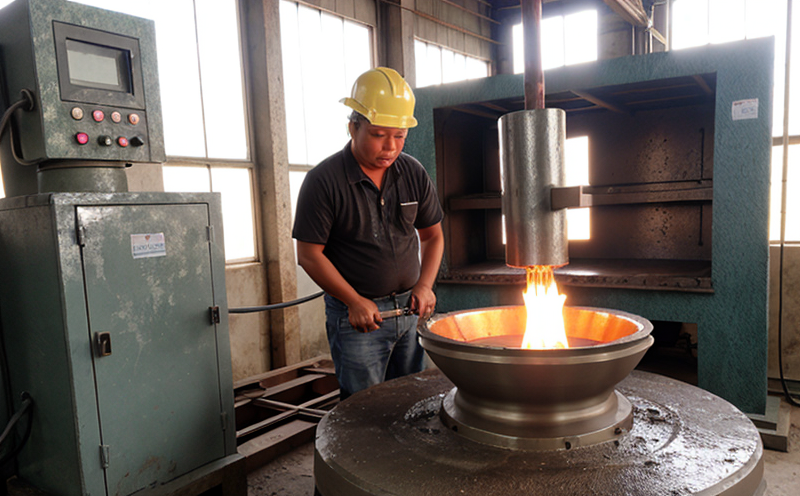ISO 8095 Normalizing Testing of Cast Steels
The ISO 8095 standard is an essential guideline for normalizing cast steels, a process that involves heating the steel to a specific temperature and then cooling it slowly. This process refines the grain structure of the metal, enhancing its mechanical properties such as strength, toughness, and ductility. Normalizing is particularly crucial in industrial manufacturing and processing where high-quality materials are essential for safety and performance.
Our ISO 8095 normalizing testing service ensures that cast steels meet stringent quality standards to support critical applications across various industries. From automotive to aerospace, the precision of this process can significantly impact product performance and reliability. Our team of experts uses advanced equipment and adheres strictly to international standards to provide accurate results.
The first step in our testing involves carefully preparing the cast steel specimen according to ISO 8095 requirements. This includes ensuring that the sample is representative of the entire batch, which allows for accurate assessment of material properties. Once prepared, the sample undergoes heating to a specific temperature range (typically between 723°C and 930°C) depending on the steel alloy type.
After reaching the desired temperature, the specimen is held there long enough to allow the grain structure to stabilize. Following this, it cools slowly through a controlled atmosphere or furnace. This slow cooling process is critical in preventing any distortion that could affect the final product's integrity. After normalization, the sample undergoes detailed inspection and analysis using various techniques like optical microscopy or metallographic examination.
The acceptance criteria for cast steels normalized according to ISO 8095 are based on visual appearance and microstructure evaluation. A properly normalized steel should have a fine pearlite structure with no visible segregation. Additionally, hardness testing may be conducted using methods such as Rockwell or Brinell scales to ensure the material meets the specified mechanical property requirements.
Our laboratory uses state-of-the-art equipment and experienced technicians who are fully trained in executing ISO 8095 procedures accurately. This ensures that every test result is reliable and can be trusted by clients involved in industrial manufacturing and processing operations. By partnering with us, you gain access to precise testing capabilities that help maintain high standards of quality control throughout your supply chain.
Our comprehensive approach not only meets but exceeds the expectations set forth by ISO 8095, ensuring consistent and superior results for all clients. Whether it's for compliance purposes or simply enhancing product performance, our service provides peace of mind knowing that each batch of cast steel has been thoroughly evaluated against these stringent standards.
Industry Applications
The application of ISO 8095 normalizing testing extends across numerous sectors within industrial manufacturing and processing. In automotive manufacturing, normalized cast steels are used for engine blocks, transmission components, and other high-stress parts where strength and durability are paramount.
In aerospace engineering, these processes play a vital role in producing lightweight yet robust structural elements like landing gear or turbine blades. The stringent quality controls associated with this testing ensure that materials can withstand extreme conditions without compromising safety or efficiency.
For heavy machinery production, normalized cast steels provide the necessary durability and resistance required for components such as gears or bearings used in construction equipment or mining operations. This ensures longevity under harsh operating environments while maintaining optimal performance levels.
In addition to these major industries, ISO 8095 normalization testing also finds utility within smaller manufacturing businesses focused on producing specialized parts for niche markets like medical devices or sports equipment. By adhering strictly to international standards such as this one, companies can ensure their products meet rigorous quality benchmarks demanded by both domestic and international customers.
Quality and Reliability Assurance
Adhering to ISO 8095 during the normalization process ensures that cast steels possess consistent microstructures throughout, which translates into uniform mechanical properties. This consistency is crucial in maintaining quality across large production runs or batches of material.
The use of precise temperature control and slow cooling methods helps eliminate any potential defects resulting from improper heat treatment processes. These defects could include excessive grain growth or internal stress concentrations that might weaken the overall structure over time.
Regular audits conducted by independent third parties help verify compliance with ISO 8095 standards throughout the entire production cycle, including raw material procurement through final inspection. This continuous monitoring ensures that all steps are executed correctly and consistently, thereby enhancing both product quality and customer satisfaction.
We understand the importance of maintaining high standards in industrial manufacturing processes; therefore, we invest heavily in personnel training, equipment upgrades, and ongoing certification programs to stay abreast of industry best practices. Our commitment to excellence guarantees that every test performed adheres meticulously to ISO 8095 guidelines, providing clients with confidence in their choices.
Use Cases and Application Examples
| Application | Description |
|---|---|
| Aerospace Engine Components | Ensures durability under extreme temperatures and pressures. |
| Automotive Transmission Systems | Improves strength and resistance to wear. |
| Construction Equipment Bearings | Maintains reliability in heavy-duty applications. |
| Medical Device Manufacturing | Guarantees precision and consistency in surgical instruments. |
| Marine Propulsion Systems | Promotes longevity and efficiency in maritime operations. |
| Railway Rolling Stock Frames | Ensures safe and reliable transportation systems. |
| Power Generation Turbine Blades | Enhances performance while minimizing maintenance costs. |
| Military Aircraft Structures | Achieves superior material properties for critical components. |
In each of these applications, ISO 8095 normalization testing plays a key role in ensuring that cast steels meet the necessary quality standards. By adhering strictly to this international standard during manufacturing processes, industries can achieve consistent results and enhanced product performance across all sectors.





